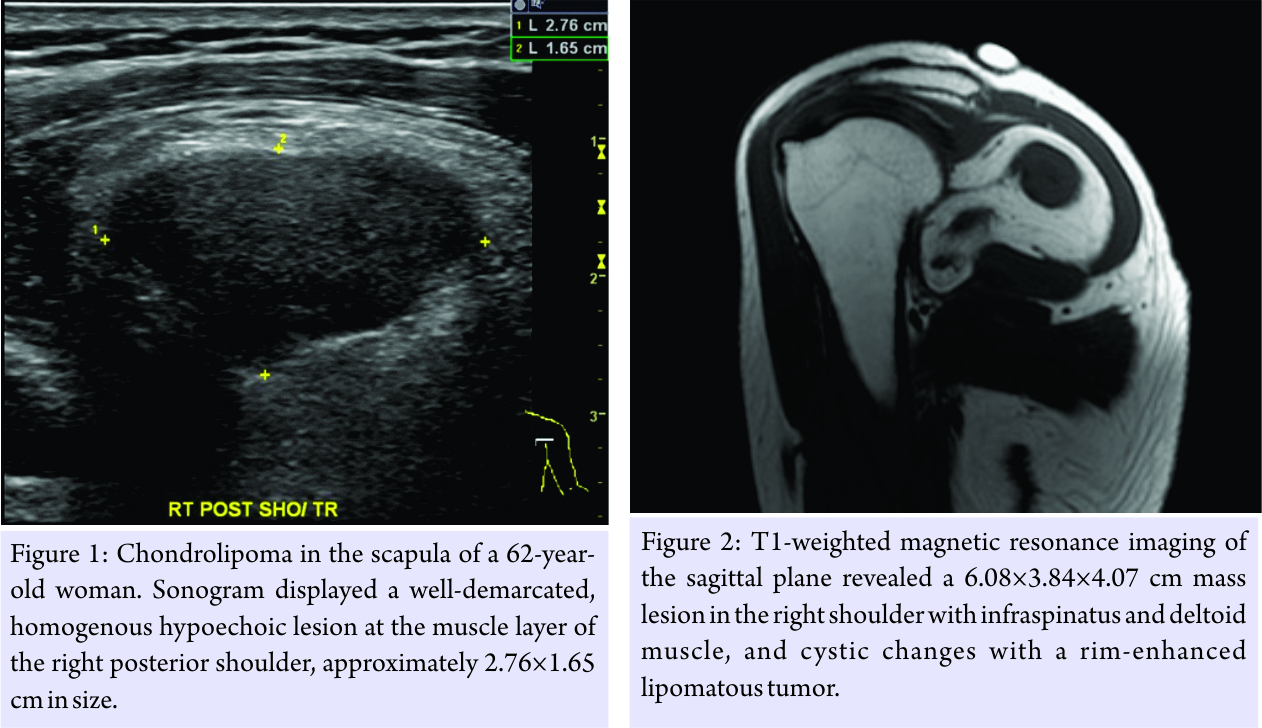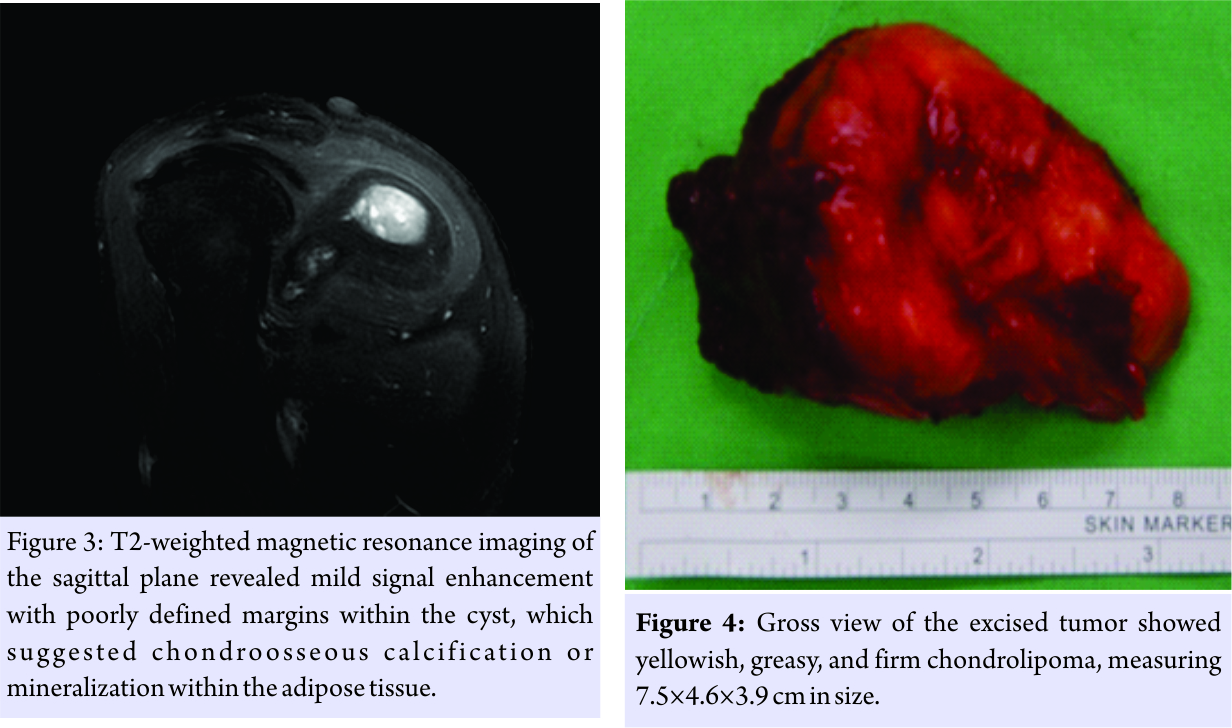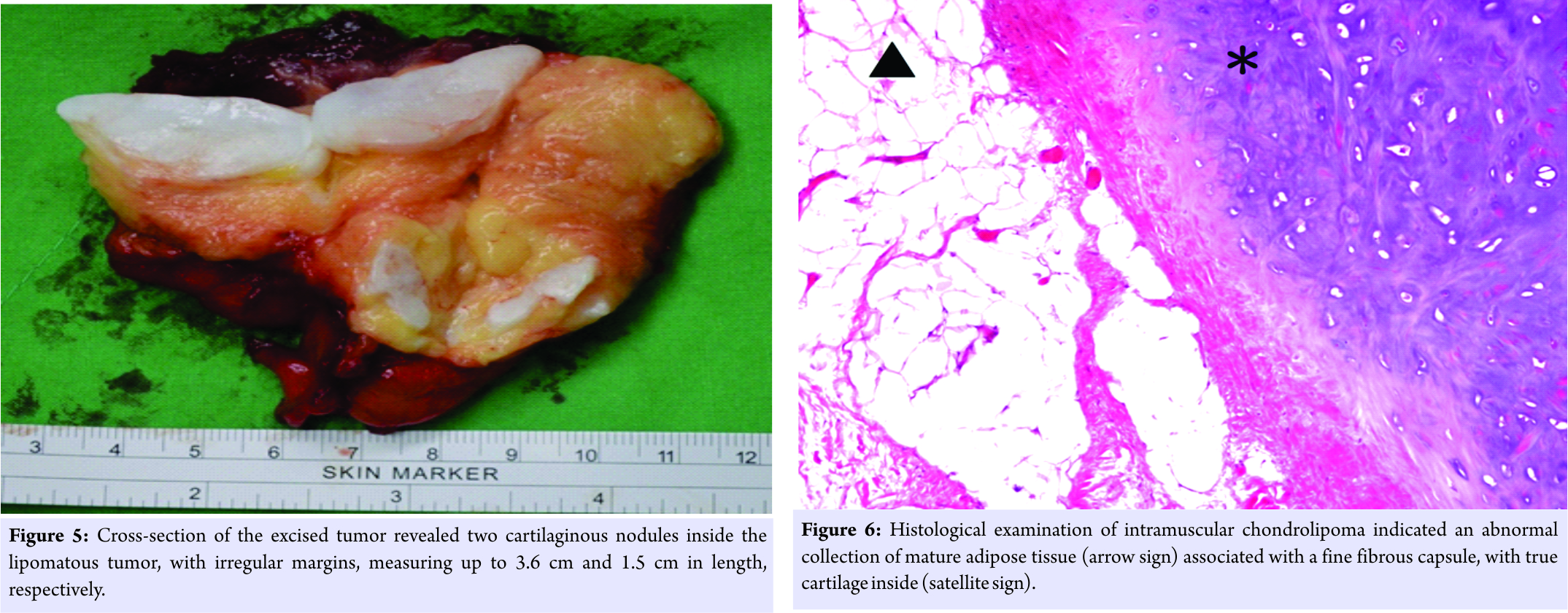[box type=”bio”] Learning Points for this Article: [/box]
Even though there’s high sensitivity of magnetic resonance imaging examination, sonographic survey is still indispensable for the precise diagnosis for chondrolipoma.
Case Report | Volume 7 | Issue 6 | JOCR November – December 2017 | Page 64-67| Ying-Cheng Huang, Shan-Wei Yang, Chun-Yu Chen, Jenn-Huei Renn. DOI: 10.13107/jocr.2250-0685.952
Authors: Ying-Cheng Huang [1], Shan-Wei Yang [1], Chun-Yu Chen [1], Jenn-Huei Renn [1]
[1] Department of Orthopedics, Kaohsiung Veterans General Hospital, Kaohsiung, Taiwan, ROC.
Address of Correspondence:
Dr. Shan-Wei Yang,
Department of Orthopedics, Kaohsiung Veterans General Hospital, No. 386, Ta-Chung 1st Rd., Kaohsiung 81346, Taiwan, ROC.
E-mail: yangshanwei@yahoo.com.tw
Abstract
Introduction: hondrolipoma located in an unusual area of the scapula. Our case is interesting because magnetic resonance imaging (MRI) that shows lipomatous tumor masses with cartilaginous nodules may mislead surgeons into not considering the possibility of chondrolipomas.
Case Report: A 62-year-old female, without any systemic disease, trauma, or history of surgery, presented with a unique case of a large intramuscular chondrolipoma of the scapula. This protruding lump over the right shoulder was present for 3 months in the patient without pain or limited range of motion. A sonographic evaluation revealed a homogeneous hypoechoic lesion in the posterior right shoulder. MRI showed that the chondrolipoma measured 7.5 × 4.6 × 3.9 cm, without remarkable bony invasion, with high signal intensity over the mass in T1-weighted images, indicating cystic changes, and mild signal enhancement within the cyst in T2-weighted images. Surgical marginal excision was performed. We identified yellowish, greasy, and firm soft tissue and two cartilaginous nodules inside the lipomatous tissue. Pathological findings revealed mature adipose tissue with a fibrous capsule and true cartilage inside. Post-operative outpatient follow-up found no recurrence after 2 years.
Conclusion: Intramuscular chondrolipoma arising from the shoulder has been rarely reported. MRI and sonography are helpful in the diagnosis.
Keywords: Chondrolipoma, Lipoma, Shoulder, Scapula, Magnetic resonance imaging, Wide excision.
Introduction
Chondrolipomas are rare forms of benign mesenchymomas containing mature cartilage and adipose tissue. Mesenchymomas are tumors composed of at least two mesenchymal tissues in addition to fibrous elements [1]. They can occur in almost any region of the body, particularly in the soft tissues of the skeletal system, breast, pharynx, and nasopharynx. To date, only a limited number of cases of chondrolipomas have been reported. To the best of our knowledge, only one case of chondrolipoma in the shoulder area has been reported [2]. Here, we report a case of an intramuscular chondrolipoma of the scapula and describe the findings of sonography, magnetic resonance imaging (MRI), and pathological examination.
Case Report
A 62-year-old woman presented with a protruding lump over the posterior right shoulder, which was present for 3 months, without pain or limited range of motion. She had no systemic disease, trauma, or history of surgery. A soft, firm lump over the right scapula was noted. A sonographic evaluation revealed a homogeneous hypoechoic lesion measuring approximately 2.76 × 1.65 cm, which arose from the muscle layer of the right posterior shoulder (Fig. 1). 

Discussion
The term mesenchymoma was originally defined by Stout in 1948 to describe tumors containing at least two mesenchymal tissues not normally found together [1]. Chondrolipomas are benign, cartilage-containing mesenchymomas of the soft tissues. They are rare lesions that should be treated by surgical excision. Two explanations for the pathogenesis of cartilage formation in benign mesenchymomas have been proposed [2]. The cartilage may arise from the chondro-osseous metaplasia of the adipose tissue, presumably as a result of mechanical stress or trophic disturbance. Alternatively, the cartilage may spontaneously originate from multipotential cells in the mesenchymoma [3, 4, 5]. Weiss et al. suggested that mesenchymal metaplasia leads to cartilage and bone formation in the adipose tissue [6]. Chondrolipomas are rare forms of lipomas with cartilaginous metaplasia, which may be found in almost any part of the body, particularly in the connective tissue of the breast, head and neck area, and skeletal muscles [7]. Several cases of chondrolipomas have been reported, arising in the extremities, such as the palm, sole, toe, thigh, and popliteal fossa, as well as in the head and neck [4, 5, 8, 9, 10, 11]. A case of a chondrolipoma that arose from the pelvic cavity has also been reported [12]. Radiographic images of lipoma subtypes have been reported [6]. However, the radiographic features of chondrolipomas have not been described in detail. MRI findings in our patient were a bright signal over the mass in T1-weighted images, indicating cystic changes, and mild signal enhancement within the cyst in T2-weighted images. As in the previous case reports, this heterogeneous signal intensity showed no remarkable differences in MRI findings [13]. Macroscopic observations during the operation and the pathological results showed that the nonlipomatous area was a cartilaginous lesion with ossification. In chondromas and enchondromas, T2-weighted images of chondromatous lesions show a mixture of low- and high-intensity areas, indicating a lobulated structure with variable calcification [13]. In our patient, these features were not seen. Hemangiomas associated with adipose tissue and mineralization with poorly defined margins should be considered as a possible diagnosis in our patient, given that the patient’s MRI findings were generally similar to those of hemangiomas. Sonographic imaging of hemangiomas usually shows hyperechoic density rather than hypoechoic density, as found in our patient’s chondrolipoma. In addition, central ossification in our patient’s tumor, as shown by radiography, indicated a chondrolipoma rather than a phlebolith associated with a hemangioma. Pathological examination revealed a cartilage component of the tumor; however, it was uncertain whether ossification developed from enchondral ossification in the cartilaginous area or from lipomatous tissue differentiation. Cartilaginous tumors occur with ossification in the chondroid matrix such as synovial chondromatosis, enchondromas, and soft-tissue chondromas. Recent studies have reported that adipose-derived stem cells possess the capability for myogenesis, osteogenesis, and chondrogenesis. In our patient, the location of ossification was focal in line with the pattern of chondrogenesis. We hypothesized that ossification in the chondrolipoma occurred by enchondral ossification over a long period of time. On the basis of imaging and pathological findings, our patient was finally diagnosed as having an ossifying chondrolipoma rather than an osteochondrolipoma.
Conclusion
Intramuscular chondrolipoma arising from the shoulder has been rarely reported. We report a case of a chondrolipoma of the scapula that arose from the right posterior shoulder with attachments to the infraspinatus and deltoid muscles. MRI and sonography are useful for diagnosis. The treatment of choice for chondrolipomas is surgical excision.
Clinical Message
Diagnosis with imaging for chondrolipomas and fatty tumors is challenging, because chondrolipomas involved chondroosseous differentiation. Even though the high sensitivity of MRI examination, sonographic survey is still indispensable for precise diagnosis.
References
1. Stout AP. Mesenchymoma, the mixed tumor of mesenchymal derivatives. Ann Surg 1948;127:278-90.
2. Nakano M, Arai E, Nakajima Y, Nakamura H, Miyazono K, Hirose T. Immunohistochemical study of chondrolipoma; possible importance of transforming growth factor (TGF)-betas, la-tent TGF-beta binding protein-1(LTBP-1), and bone morphogenetic protein (BMP) for chon-drogenesis in lipoma. J Dermatol 2003;30:189-95.
3. Jone AC, Trochesset D, Freedman PD. Intraoral benign mesenchymoma: A report of 10 cases and review of the literature. Oral Surg Oral Med Oral Pathol Oral Radiol Endod 2003;95:67-76.
4. Candocia FJ, Barlev DM. Chondrolipoma in the palm of a child: Sonographic and MR find-ings. Clin Imaging 2004;28:206-8.
5. Ohtsuka H. Chondrolipoma of the popliteal fossa and Japanese reports. J Dermatol 2006;33:202-6.
6. Weiss SW, Goldblum JR. Benign lipomatous tumors. In: John R, Goldblum JR, Weiss SW, Folpe AL, editors. Enzinger and Weiss’s Soft Tissue Tumors. St. Louis: Mosby; 2001. p. 571-639.
7. Banev SG, Filipovski VA. Chondrolipoma of the breast-case report and a review of literature. Breast 2006;15:425-6.
8. Takoto T, Soyano S, Naka Y, Mishina M. Benign mesenchymoma of the sole. Ann Plast Surg 1984;3:150-3.
9. Ito R, Fujiwara M, Takagaki K, Nagasako R. Chondrolipoma of the toe. J Dermatol 2007;34:570-2.
10. Boltze C, Hribaschek A, Lippert H, Roessner A. Intermuscular chondrolipoma of the thigh: The diagnostic way of a rare entity. Pathol Res Pract 2003;199:503-7.
11. Pitman KT, Bell D. Chondrolipoma of head and neck: Case report and review of literature. Head Neck 2013;35:E18-20.
12. Hwang HS, Lee WJ, Lim HK, Chun HK, Ahn GH. Chondrolipoma in the pelvic cavity: A case report. Korean J Radiol 2008;9:563-7.
13. Tomonaga M, Kudawara I. Ossifying chondrolipoma of the thigh: Radiographic pathologic correlation. Curr Orthop Pract 2014;25:493-6.
 |
 |
 |
 |
| Dr. Ying-Cheng Huang | Dr. Shan-Wei Yang | Dr. Chun-Yu Chen | Dr. Jenn-Huei Renn |
| How to Cite This Article: Huang YC, Yang SW, Chen CY, Renn JH. An Intramuscular Chondrolipoma of the Scapula: A Case Report of a Rare Tumor in an Unusual Location. Journal of Orthopaedic Case Reports 2017 Nov-Dec; 7(6): 64-67. |
[Full Text HTML] [Full Text PDF] [XML]
[rate_this_page]
Dear Reader, We are very excited about New Features in JOCR. Please do let us know what you think by Clicking on the Sliding “Feedback Form” button on the <<< left of the page or sending a mail to us at editor.jocr@gmail.com





